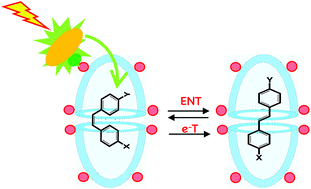Remote electron and energy transfer sensitized photoisomerization of encapsulated stilbenes†
Abstract
Excited state chemistry and physics of molecules, in addition to their inherent electronic and steric features, depend on their immediate microenvironments. This study explores the influence of an organic capsule, slightly larger than the reactant molecule itself, on the excited state chemistry of the encapsulated molecule. Results presented here show that the confined molecule, in fact, is not isolated and can be manipulated from outside even without direct physical interaction. Examples where communication between a confined molecule and a free molecule present outside is brought about through electronic and energy transfer processes are presented. Geometric isomerization of octa acid encapsulated stilbenes induced by energy and electron transfer by cationic sensitizers that attach themselves to the anionic capsule is examined. The fact that isomerization occurs when the sensitizer present outside is excited illustrates that the reactant and sensitizer are communicating across the molecular wall of the capsule. Ability to remotely activate a confined molecule opens up new opportunities to bring about reactions of confined radical ions and triplet excited molecules generated via long distance energy and electron transfer processes.



 Please wait while we load your content...
Please wait while we load your content...
